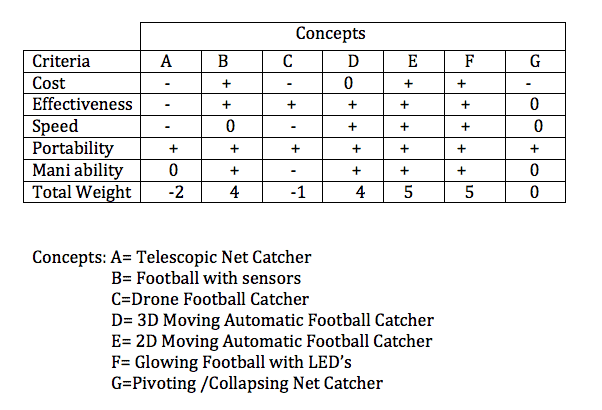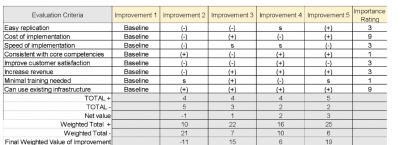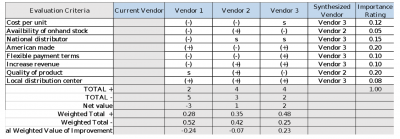
Key Points
- The Pugh Matrix is intended to empower the decision-making process.
- The matrix takes multiple criteria and allows users to weigh them to make decisions.
- Correct usage of the matrix allows for swift decision-making, ignoring non-viable alternatives to solving a problem.
- The tool integrates readily into Six Sigma methodology, using hard data to promote solid decisions.
Scottish scientist Dr. Stuart Pugh developed a method for improvement selection called Pugh’s Controlled Convergence. More commonly known as the Pugh Matrix, it formalizes the decision-making process to help you select one or more improvement opportunities to pursue in detail.
The Pugh Matrix uses specified evaluation criteria to compare alternative improvement opportunities.
Overview: What Is the Pugh Matrix?

The Pugh Matrix is a decision-making tool to compare multiple alternatives. The steps that you will take to create your Pugh Matrix are:
- Define your evaluation criteria. What are the most important and desired characteristics of your solution?
- Weight your evaluation criteria as to the relative importance of each.
- Define your different improvement alternatives and optional approaches.
- Select a “BASELINE” from the alternatives, which will typically be your current state.
- For each criterion, rate each alternative as better, same, or worse than your baseline. You can use a simple + for better, s for same, and – for worse.
- Total the count of each.
- Select your best alternative.
- Explore whether an even more optimal solution might exist by creating a hybrid of the best from various alternatives.
Define Your Evaluation Criteria (Usually from the Voice of the Customer and/or Voice of the Business)
- Critical Customer Requirements (CCRs)
- Voice of the Business
- Alignment with your strategy
- Your cost/benefit impact
- Time required for full implementation
- The amount of your capital investment
- Your ongoing operating cost
- Your risk to implement
- Regulatory/Other
- Adherence to regulatory requirements
- Safety
- Environment
- Political and policy constraints
Weigh Your Evaluation Criteria
- Use a numeric scale
- The scale you chose can be 1-5 or 1,3,9 or any other naming scheme. The exact scale that you select is not that critical since you will be ranking your alternatives in terms of relative importance.
- You can also use a relative percentage of each criterion against a total of 100%.
- Be sure that you discuss the ranking method with the team and the process manager so that everyone agrees on the definition.
Define Your Alternative Solutions and Select a Baseline to Compare the Options to
- Your choice of a baseline is not that critical, because all the comparisons you make will be relative.
- Your current process is usually the best choice for a baseline. You and the team will already understand the evaluation criteria as they are applied to the baseline.
Rate Each Alternative Against Your Baseline
- Use (+) if one of the alternatives is better in terms of the evaluation criteria.
- Use (s) if the alternative is the same as the baseline.
- Use (–) if the alternative is worse than the baseline.
- You can use multiples of + or – if you believe the alternative is significantly better or worse than the baseline.
Do the Computations and Determine the Best Idea

- Sum the (+)s and (-)s for each improvement idea to compute the total for the + and -.
- Multiply the (+)s and (-)s for each improvement idea by the importance rating (weights) and sum vertically to compute the weighted total for each Improvement idea.
- Don’t worry about the actual values. They don’t mean anything. It is the relative value of each idea, not the absolute value.
Note that in our example above, Improvement 5 seems to be the best solution because of its final weighted value of 19. Take another look at the matrix and see if you can come up with a synthesized solution that would combine the pluses of the various solutions while eliminating the minuses. This could then become an alternative improvement idea. Run through the entire comparison process again and see if your proposed synthesized solution is, in fact, the best one.
Benefits of the Pugh Matrix

Comparing and evaluating competing improvement ideas can be quite tedious. Using the Pugh Matrix as a first screening of ideas will allow you to narrow down your options quickly and easily — and possibly even come up with a hybrid synthesized solution.
Simple Tool to Evaluate and Compare Alternative Improvement Solutions
Using a table format and simple + and –, you can evaluate and compare solutions using simple arithmetic computations.
Quickly Eliminates Non-viable Solutions
By eliminating the solutions with an overabundance of – ratings, you won’t waste time pursuing any further evaluation of that alternative.
Allows for Efficient Synthesizing the Best from All Possible Alternatives
Once you’ve ranked the alternative solutions, you can create a stronger option by taking the best of each alternative while eliminating the negatives of each.
RELATED: PUGH MATRIX VS. ANALYTICAL HIERARCHY PROCESS
Why Is the Pugh Matrix Important to Understand?
All improvement initiatives eventually get to the point where you need to decide between different viable solutions. If you know how to use the Pugh Matrix, you can streamline your evaluation process.
It Drives You to Identify the Appropriate Criteria
You need to select the desired outcomes so you can focus your improvement ideas on the correct things.
You Must Understand the Concept of Relative Weighting
All evaluation criteria are not equal in their impact on improving the process. You need to assess the degree to which you weigh each one.
Not Every Solution Will Be a Perfect One
By building a synthesized solution from the best of the alternatives, you will likely come up with your optimal improvement idea.
Limitations and Drawbacks of the Pugh Matrix
Like any tool in the toolbox, there are some places where the Pugh Matrix falls short. Since the matrix is so dependent on human input, it is subject to bias. This bias can influence decision-making, sometimes in a negative manner.
Further, since this is a high-level look at various criteria, it doesn’t account for the variables and dependencies that might exist. This, in turn, could lead to wasted time. As such, you want to make sure you drill down to brass tacks when it comes to designing your Pugh Matrix.
An Industry Example of a Pugh Matrix
A hospital system was trying to decide on a new vendor for some of their critical PPE supplies. They weren’t sure whether their current vendor was the best one in the marketplace. It also determined the criteria that they wanted to use to compare three other vendors with the current one. They also weighted the various criteria and ranked them against the importance of the criteria.
Using the Pugh Matrix, they decided on the vendor that most satisfied their criteria. But they didn’t stop there. They used the best of each criterion and created a new set of requirements for their RFPs going forward. Below is what their matrix looked like.

Best Practices When Thinking About the Pugh Matrix
It is best if you use a team to do the Pugh Matrix. Here are a few tips to make the process go smoothly.
Carefully Choose and Agree on the Evaluation Criteria
Don’t use too many criteria otherwise, you can slow the process down. Remember that this is a first screening and not a final in-depth analysis.
Select a Rating and Weighting Scheme that Everyone Understands
Be sure that you operationally define what a plus or minus means as well as any weighting system. You can use a number format or a percent.
Look for the Strengths and Weaknesses
Build on the positives and evaluate what you might be able to do to turn the negatives into a positive.
Other Tools of the Trade
Making decisions is just one aspect of process improvement. While we’ve taken some time to look over how useful the Pugh Matrix is, you might be curious about other tools to aid you in your quest for the best possible deliverable. In that case, I suggest taking a moment to read over our guide on the 6Ms. This handy tool is a fast and easy way of solving problems, cutting through the fat to get to the heart of the matter.
Further, you might be looking to nip problems in the bud before they ever happen. In that case, you’d be best served by looking into Poka-Yoke. This handy methodology accounts for defects before they even arise. Our guide is a fairly brisk read that’ll get you up to speed on the concepts and implementation.
Last Thoughts on the Pugh Matrix
The Pugh Matrix can be used to select the best improvements from various alternatives. You first want to identify the factors that are most important to you. One improvement is selected as the baseline, and you then weigh the criteria as to their relative importance. Eliminate those improvement concepts that have few positives.
Focus on the positives and eliminate or mitigate the negatives for the improvement that appears superior after the first round. You can use the Matrix results to spur another round of improvement generation.